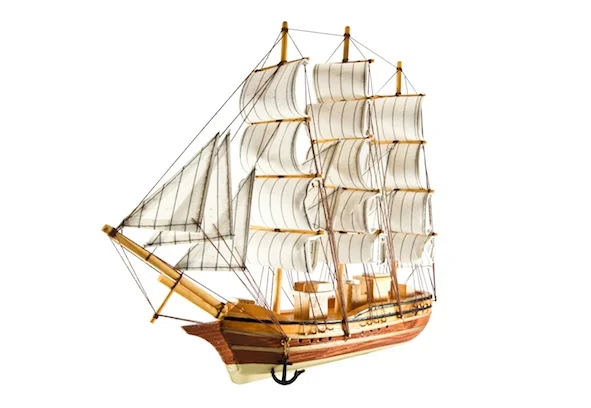The first boats were made thousands of years ago.
Ships and boats are used for travel, by the armed forces for our defence, for fishing, for transporting cargo between countries, and for leisure, sport and relaxation.
Three quarters of all goods carried from country to country must cross oceans and seas in ships and boats.
Here is a timeline that shows some major developments in the building of ships and boats.
In some places, rafts are still used today, to carry people and goods across rivers and lakes. Getty Images
Many thousands of years ago, a raft made by tying several logs together with creepers, was the first kind water transport that a person could steer.
Later, people made the first real boats by hollowing out logs.
A boat made by hollowing out the middle of a log. Getty Images
A frame boat, built like a basket and covered with animal skins was another very early boat. A coating of tar kept the boat watertight.
4000 BC
Boat builders in ancient Egypt used reeds to build what were probably the first sailing boats. The Egyptian reed boats had a mast and sails and were used on the river Nile.
By 2500 BC
The Egyptians were building wooden boats that could sail across oceans.
From 1550 BC to 300 BC
The Phoenicians (people from the ancient civilisation of Canaan – now Lebanon and Syria) used the galley, a man-powered sailing vessel, to travel and trade and fighting with their neighbours.
Viking longboats. Getty Images
1000 AD
Viking longboats
These ships had sails as well as up to 60 oarsmen who rowed the ship. The longboats were long and narrow so were able to travel on the open sea, as well as along rivers.
1100 AD
Chinese junks were sailing boats with a rudder for steering the boat, battens on the sails to give them greater strength, and watertight compartments long before western ships had them. They were fighting and transport ships.
Three and four masted sailing ships.©Getty
1450 onwards
Three and four masted sailing ships were in service for several centuries. These wooden ships were used as battleships, by explorers, and as trade vessels carrying cargo from country to country.
Christopher Columbus sailed in caravels on his voyages from Spain to Americas ©iStock
The caravel, a small, fast and easier to maneuvre kind of ship than earlier sailing ships, were built by the Portuguese. Prince Henry of Portugal who became known as Henry the Navigator is said to be the inventor. (maybe not true!) But they were used by Portuguese to explore the coasts of Africa.
Clipper ships were faster than older style sailing ships
1800s
In the 1800s, fast sailing ships called 'clipper ships' were built. They had long, slim hulls and tall masts.
Steam power and wind power were both used on ships like this.
1819
The first steamships to cross the Atlantic combined steam and wind power.
Huge propellers powered iron ships across the oceans
1845
The first ocean-going liners made of iron and driven by a propeller were being built from this time. The propellers were on the bottom of the ship, underwater at the rear (stern) of the ship.
1880s
Paddle steamers like this were used mainly for river transport
Some steam driven river boats had rear paddles and were called 'stern wheelers' while others had paddle wheels on either side.
Ocean liners switched to using oil in 1910
1910
Coal-burning sailing ships were converted to diesel power, using oil instead of steam.
1955
Hovercraft float above the water on a cushion of air. Getty Images
Hovercraft could float above the waves on cushions of air and were capable of speeds of up to 140 km an hour.
The idea for the modern hovercraft came from Christopher Cockerell who built several models of his hovercraft design in the early 1950s. His hovercraft had an engine mounted to blow from the front of the craft into a space below it, combining both lift and propulsion. Although he presented his hovercraft ideas to the military, they were not interested.
Nuclear power is used to power cargo ships in 1959
1959
The N.S. Savannah, one of the first nuclear powered cargo ships, was able to sail for three and a half years without refuelling.
Hydrofoils are mostly used as ferries or water taxis. Getty
1980s
Hydrofoil used as ferries or water taxis. Hydrofoils ride on wings that lift the boat clear of the water so that it rides on skis as it gains speed.
Container ships carry cargo. Getty Images
Container ships carry cargo in huge, metal boxes which are stacked on the deck. A modern cargo ship can carry up to one thousand containers.
All containers are the same size and they are unloaded at ports which are equipped with special cranes. That containers are loaded onto trucks to be taken from the port.
Among the largest ships ever built, these supertankers are used to transport oil. Getty Images
Cruise ships are like floating cities. Getty Images
1990s and 2000s
Cruise liners are ships that carry many hundreds, or even thousands of people on floating holidays. Passengers live on the ship, which has restaurants, shops, cinemas and other recreation venues.
A nuclear powered submarine
Modern nuclear powered aircraft carriers, battle cruisers, destroyers, and nuclear powered submarines are all used to keep a country safe and to protect its territory.



















